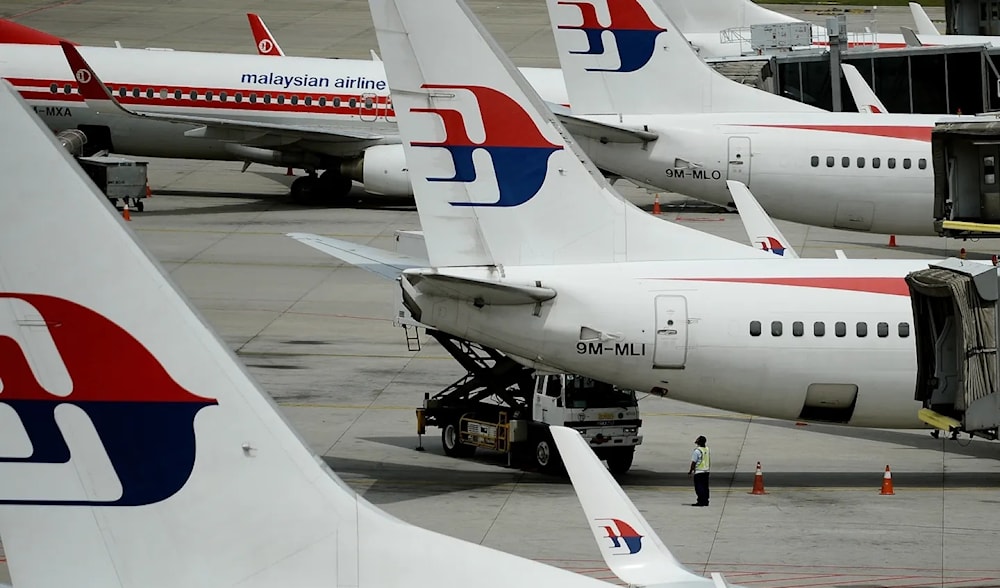Search for long-missing flight MH370 suspended: Malaysian minister
The search for Malaysia Airlines flight MH370 has been suspended. The Boeing 777 disappeared in 2014 with 239 people on board. Ocean Infinity, which resumed the search earlier this year, halted the search due to weather and prior commitments.
-

Malaysia Airlines ground staff walk past Malaysia Airlines aircraft parked on the tarmac at the Kuala Lumpur International Airport in Sepang on June 20, 2016. (AFP)
The latest search for Malaysia Airlines flight MH370 has been suspended more than a decade after the plane went missing. The Boeing 777 carrying 227 passengers and 12 crew members disappeared from radar screens on March 8, 2014, while en route from Kuala Lumpur to Beijing.
Kuala Lumpur's Transport Minister, Anthony Loke, said in a voice recording sent to AFP on Thursday, "They have stopped the operation for the time being, they will resume the search at the end of this year." Loke's comments come just one month after Malaysian authorities said the search had resumed, following a decade's worth of failed attempts that have covered vast swaths of the Indian Ocean.
"Right now, it's not the season," Loke said in a recording made during an event at Kuala Lumpur International Airport last Wednesday.
The 2025 search has been put on hold "due to seasonal weather changes and unavoidable prior commercial commitments", a separate statement posted on the "MH370 Families" Facebook group said.
The search
Over the last eleven years, the search for Malaysia Airlines Flight MH370 has been a collaborative effort involving both government ministries and the private sector. Following the aircraft's disappearance in 2014, the Malaysian government, in partnership with Australia and China, initiated an extensive search operation in the southern Indian Ocean.
The initial search for the plane, a 52-day surface search, covered an area of several million square kilometers (square miles) in the Indian Ocean, west of Australia, before an underwater search mapped 710,000 km² (274,000 square miles). According to the Australian Transport Safety Bureau (ATSB), these searches represent the largest aviation searches of their kind in history.
A later Australia-led search covered a more narrowed search of 120,000 km² (46,300 square miles) in the Indian Ocean. The search spanned over three years, but found hardly any trace of the plane other than a few pieces of debris.
The multinational search effort was called off on January 17, 2017, becoming the most expensive search in aviation history, concluding after 1,046-days.
No-find no-fee
Later in 2018, the Malaysian government entered into a "no-find, no-fee" agreement with the US-based private marine technology company, Ocean Infinity, to resume the search. Under this arrangement, Ocean Infinity would only be compensated upon the discovery of the aircraft's wreckage. The search was largely unsuccessful.
After a period of inactivity, the Malaysian government agreed in December 2024 to a new search effort led by the same firm. An agreement was signed in March 2025, and the search was expected to cover a much smaller area, at only 15,000 km² (5,791.5 square miles) in the southern Indian Ocean. Under this agreement, Ocean Infinity would receive $70 million only if significant wreckage is found.
"Whether or not it will be found will be subject to the search, nobody can anticipate," Loke said at the time, referring to the wreckage of the plane.
Numerous theories, same frustration
The disappearance of Malaysia Airlines Flight 370 has been the subject of numerous theories, ranging from credible to outlandish. One such theory suggests that veteran pilot Zaharie Ahmad Shah deliberately diverted the plane. Investigations revealed that Zaharie had plotted a course on his home flight simulator to the southern Indian Ocean, where the aircraft is believed to have crashed. However, authorities cautioned that this route was just one of thousands stored on his simulator, and there was no concrete evidence linking Zaharie to the plane's disappearance.
A Malaysian-led Independent Investigation report released in 2018 highlighted shortcomings in air traffic control procedures, including delays in initiating emergency responses and inadequate radar monitoring. The report confirmed that the plane's course was altered manually after communications were severed, but it stopped short of attributing blame to any individual, including the pilots. It also raised the possibility of "intervention by a third party," such as someone holding the pilots hostage. However, no group claimed responsibility, and no ransom demands were made.

 4 Min Read
4 Min Read








